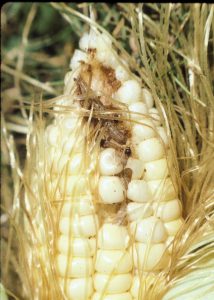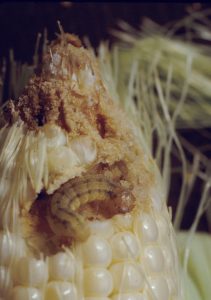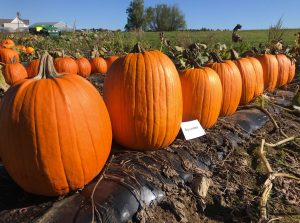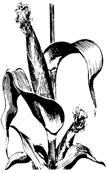Sweet Corn IPM Newsletter No. 11 – September 2, 2022
Sweet Corn IPM Newsletter No. 11 – September 2, 2022
EARWORM PRESSURE HIGHER IN SOUTHERN MAINE
Fall Armyworm, European Corn Borer Pressure Remains Moderate
Highmoor Farm Twilight Meeting: Thursday, September 8, 5:30-7 p.m. Come join us for a tour of the vegetable variety trials at the Maine Agricultural Experiment Station. Pumpkins, corn, radicchio, celery, artichokes, parsnips, carrots, and more will be on display. We are located at 52 US Route 202 in Monmouth.
SITUATION
As we prepare for the holiday weekend, corn supply and quality look good. Some growers are nearing the end of their supply as the warm summer shortened maturity dates for late varieties. Corn earworm numbers were higher in all but the most northern sites, while fall armyworm and European corn borer numbers remained moderate, and western bean cutworm numbers continued to drop. Predicted cool night temperatures in the days ahead may slow insect activity in the corn fields.

European corn borer: Larval feeding injury from corn borer remains low and was not over the 15% control threshold for pre-silking corn at any of our scouting sites. Moth captures remain spotty, but generally low overall. Counts were over the 5-moth threshold for silking corn at one Dayton site, and Oxford. Both of these sites were on a spray interval for corn earworm, so no additional sprays were recommended.

Corn earworm: Moth counts increased at most locations this week, except in our most northern sites. A 6-day spray interval for silking corn was recommended at one Dayton site, Oxford, and Wells. A 5-day spray schedule was recommended for Monmouth. A 4-day spray interval was recommended in Biddeford, Bowdoinham, Cape Elizabeth, one Dayton site, Lewiston, New Gloucester, Sabattus, and Wayne.
Fall armyworm: Fall armyworm moth counts continued their decline from last week. Trap counts were only over the three-moth threshold for silking corn in Cape Elizabeth, which is on a spray interval for corn earworm, so no additional sprays should be needed. Larval feeding damage on leaves and tassels of younger corn was over threshold in Biddeford and Bowdoinham. All other sites have no pre-silking corn remaining.
Western bean cutworm: No western bean cutworm moths were caught in pheromone traps this week, suggesting this pest may be done for the season.

When Should I Stop Spraying?
When a silking corn field is under a recommended spray interval for corn earworm, we recommend that spraying be stopped once the silks have become thoroughly dried and brown. At this stage, corn earworm moths are unlikely to lay eggs on it. However, if earworm pressure is very high (e.g., 91+ moths per week) and/or fall armyworm moths are over threshold (3 or more moths per week), then spraying should continue until either the moth counts drop or you reach the required days before harvest (dh) for the product being used.
Spotted Wing Drosophila: Numbers are increasing; visit the SWD Blog at the Highmoor Farm website: https://extension.umaine.edu/highmoor/category/spotted-wing-drosophila/.
 Highmoor Farm Twilight Meeting: Thursday, September 8, 5:30-7 p.m. Come join us for a tour of the vegetable variety trials at the Maine Agricultural Experiment Station. Pumpkins, corn, radicchio, celery, artichokes, parsnips, carrots, and more will be on display. We are located at 52 US Route 202 in Monmouth.
Highmoor Farm Twilight Meeting: Thursday, September 8, 5:30-7 p.m. Come join us for a tour of the vegetable variety trials at the Maine Agricultural Experiment Station. Pumpkins, corn, radicchio, celery, artichokes, parsnips, carrots, and more will be on display. We are located at 52 US Route 202 in Monmouth.
Sincerely,
David T. Handley
Vegetable and Small Fruit Specialist
Highmoor Farm UMaine Extension Diagnostic
P.O. Box 179 Research Lab, Pest Mgmt. Unit
52 U.S. Route 202 17 Godfrey Drive
Monmouth, ME 04259 Orono, ME 04473
207.933.2100 1.800.287.0279
Sweet Corn IPM Weekly Scouting Summary
| Location | CEW
Moths |
ECB
Moths |
FAW
Moths |
%Feeding
Damage |
Recommendations / Comments |
| Biddeford | 15 | 2 | 2 | 26% | 4-day spray interval for silking corn |
| Bowdoinham | 25 | 3 | 1 | 39% | 4-day spray interval for silking corn |
| Cape Elizabeth | 10 | 2 | 8 | 4-day spray interval for silking corn | |
| Dayton I | 2 | 0 | 0 | 6-day spray interval for silking corn | |
| Dayton II | 20 | 5 | 0 | 4-day spray interval for silking corn | |
| Garland | 0 | 0 | 0 | No spray recommended | |
| Lewiston | 64 | 2 | 0 | 4-day spray interval for silking corn | |
| Lewiston II | 17 | 0 | 2 | 4-day spray interval for silking corn | |
| Monmouth | 5 | 0 | 1 | 5-day spray interval for silking corn | |
| New Gloucester | 41 | 0 | 1 | 4-day spray interval for silking corn | |
| Oxford | 2 | 10 | 2 | 6-day spray interval for silking corn | |
| Palmyra | 0 | 0 | 0 | No spray recommended | |
| Sabattus | 13 | 1 | 0 | 4-day spray interval for silking corn | |
| Wayne | 8 | 0 | 0 | 4-day spray interval for silking corn | |
| Wells I | 2 | 3 | 0 | 6-day spray interval for silking corn | |
| Wells II | 3 | 1 | 1 | 6-day spray interval for silking corn |
CEW: Corn earworm (Only fresh silking corn should be sprayed for this insect.)
ECB: European corn borer
FAW: Fall armyworm
| European Corn Borer Thresholds
Whorl stage: 30% or more of plants scouted show injury. Pre-tassel-silk: 15% or more of plants scouted show injury. Silk: 5 or more moths caught in pheromone traps in one week. |
Corn Earworm Spray Thresholds for Pheromone Traps
| Moths caught per week | Moths caught per night | Spray interval |
| 0.0 to 1.4 | 0.0 to 0.2 | No spray |
| 1.5 to 3.5 | 0.3 to 0.5 | Spray every 6 days |
| 3.6 to 7.0 | 0.6 to 1.0 | Spray every 5 days |
| 7.1 to 91 | 1.1 to 13.0 | Spray every 4 days |
| More than 91 | More than 13 | Spray every 3 days |
Thresholds apply only to corn with exposed fresh silk. Lengthen spray intervals by
one day if the maximum daily temperature is less than 80°F.
IPM Web Pages:
http://extension.umaine.edu/ipm/
http://www.pestwatch.psu.edu/sweet_corn.htm
https://ag.umass.edu/integrated-pest-management/
Where brand names or company names are used, it is for the reader’s information. No endorsement is implied nor is any discrimination intended against other products with similar ingredients. Always consult product labels for rates, application instructions, and safety precautions. Users of these products assume all associated risks.
The University of Maine is an equal opportunity/affirmative action institution.

